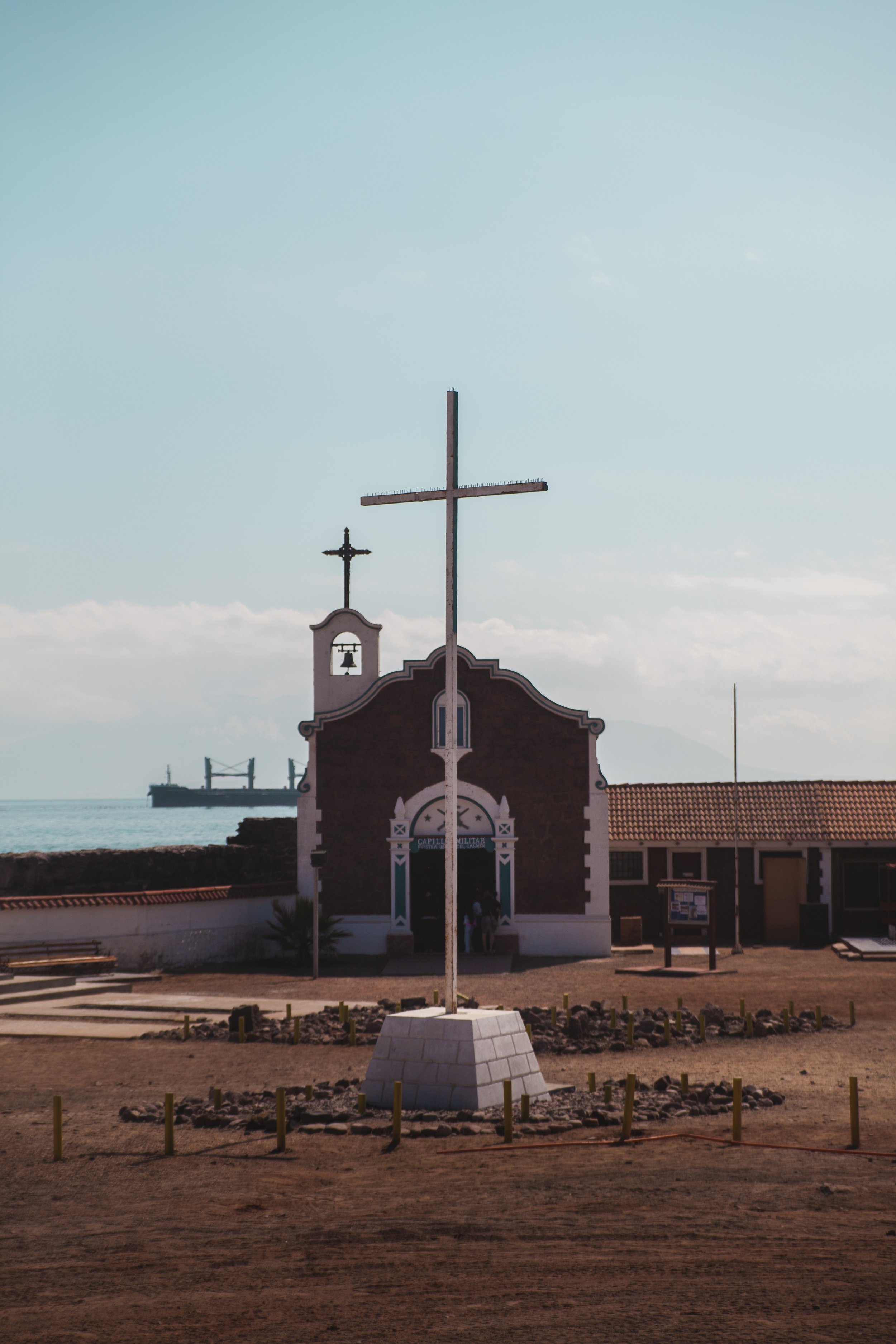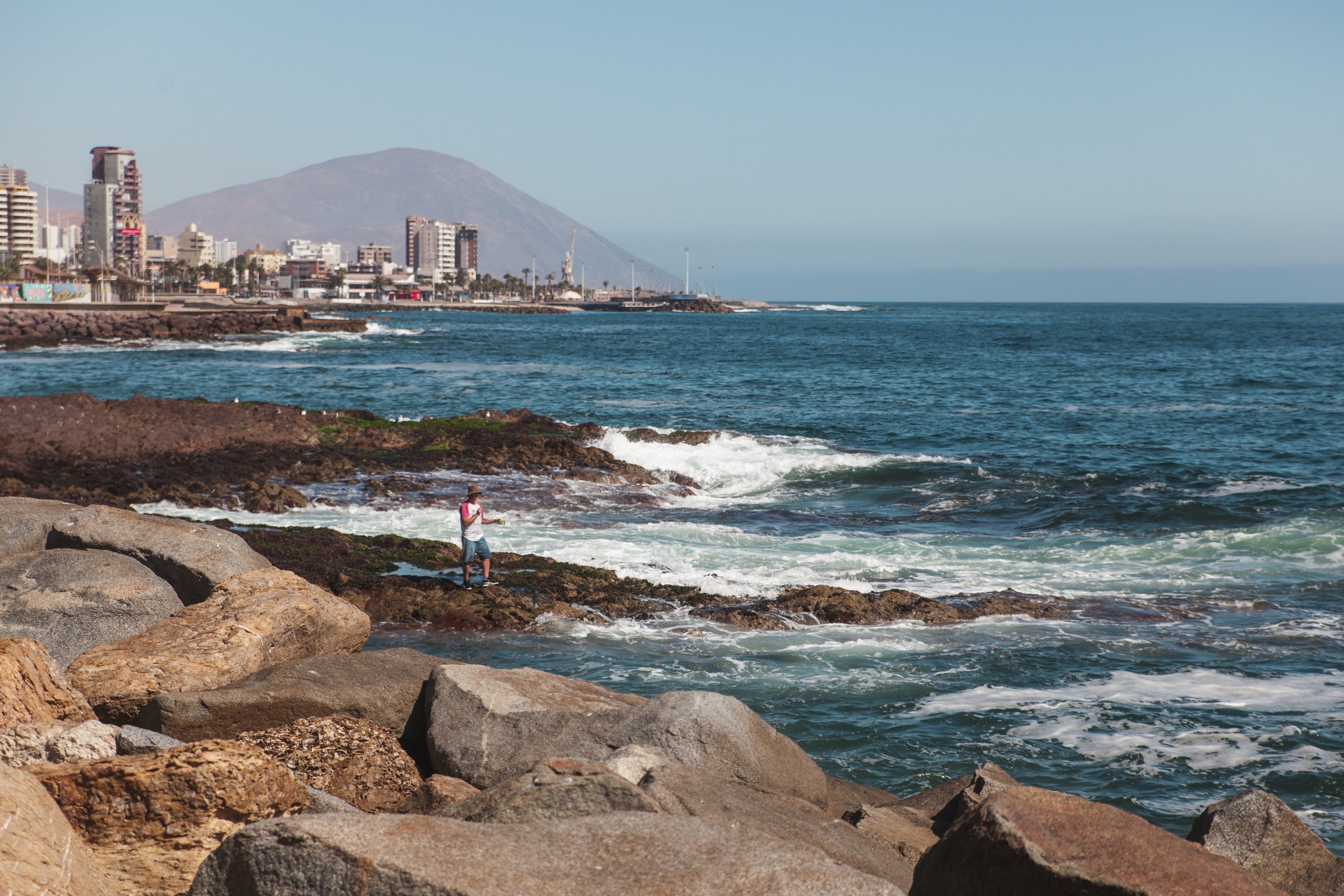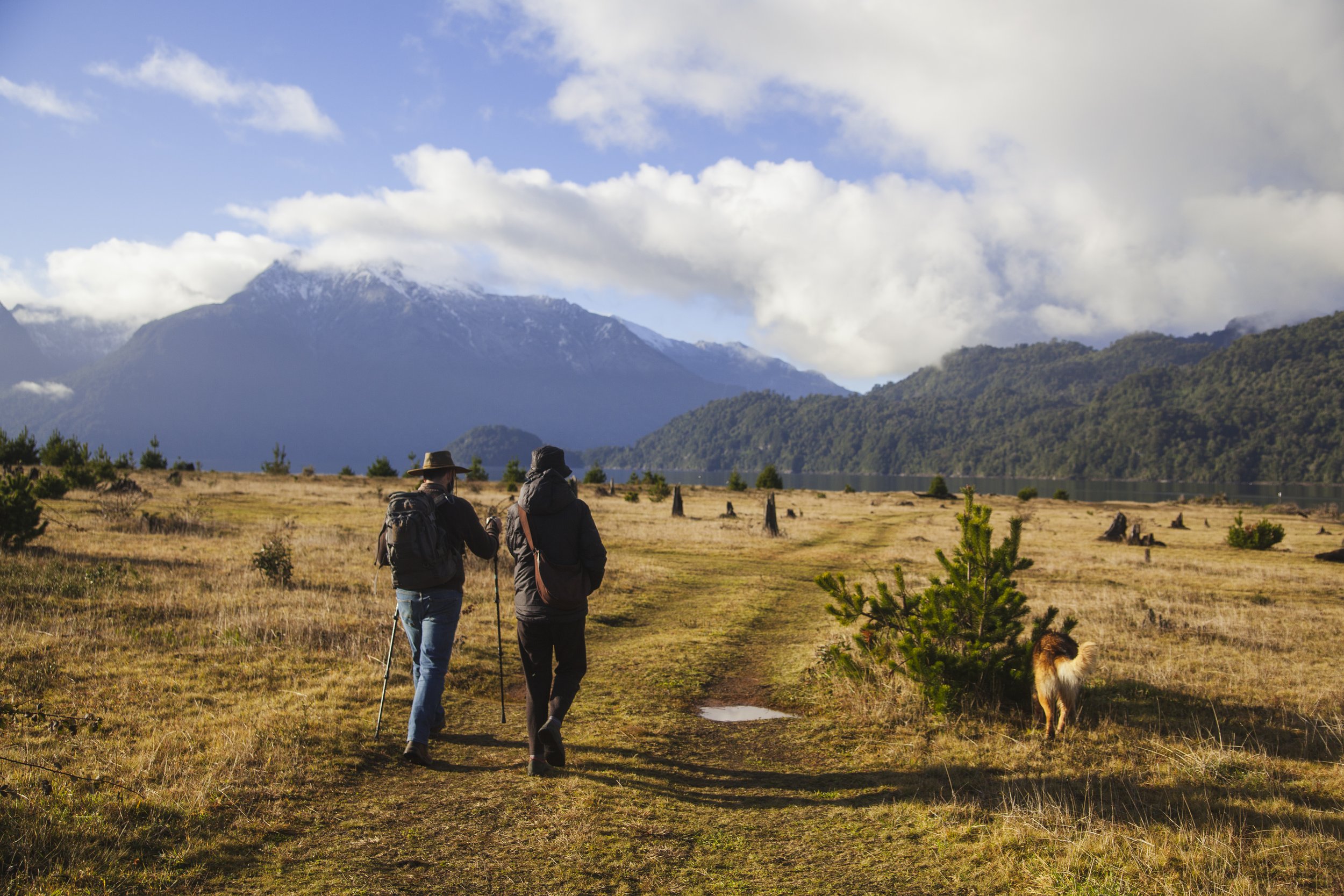Parinacota, Chile
There is a city in the furthest north of Chile, dominated by a big mountain and big waves, a free port important for Bolivia and mining interests, officially not Peruvian since 1929, but secretly independent at heart. Like most border towns, Arica resonated a lot with us, most of all because of three precious new friends that welcomed us there: Seba, Angello and Jero. We arrived in the city on the first day the land border opened since the start of the pandemic, taking the first bus from Tacna, Peru as a group of 27 hopeful travelers and counting ourselves among the 11 to have successfully crossed. It was both a celebration of the end of the pandemic restrictions and a sobering reminder of the difficulties borders present to everyday people.
Amuki is: Seba, Angello, and Jero
Amuki, the name of the organization of the our three hosts, invited us for a concert at a gallery space in the city. The space is owned by an esteemed local sculptor, Juan Diaz Fleming, whose large pieces constellate the desert landscape South of the city.
Downtown Arica is quite iconic, and the ocean is easily accessible, but one of our strongest desires was to visit the Chinchorro museum, which is situated around 20 kms out of town. One of our new friends was so generous to let us borrow his car, and so we set off on the road and into the desert. At the Chinchorro museum, you can see the oldest mummies ever found, some 9000 years old, endlessly preserved in the driest place on Earth.
The day after the concert, partying and pisco sours did not last long for us, because in the very early hours of our last day, we set out to drive to the Altiplano, some 180 kilometers east at the border of Bolivia. Chile increases in altitude quickly, and so the drive includes the entire span from sea level to the 4500 meter plateau. Because of this, we needed to be careful about altitude sickness, and additionally there are no gas stations beyond Arica, so we needed to pick up spare fuel tanks too.
The road we took is the main route of transport for fuel between the coast and inland Bolivia, so it’s in fact quite dangerous. But we throughly enjoyed the entire way past Putre and then toward Parinacota. Parinacota is a magical village of a few silent houses cuddled around a crazy church, a main square, and a school. We managed to find the Don in charge of the church, after knocking on some doors, and he was kind enough to open its doors. It was indeed something like we had never seen before, with incredible frescos and decorations, a mix of paintings in naïve styles. We were also told about the magic demonic table, that had to be tied down so that it would not fly around the village and spread death in the local houses.
Towing a car around town
A man working on his car engine outside of the church then proceeded to ask us for help, as its battery did not seem to start. And that’s how our ‘good Nissan‘ began noisily towing a second car around the village until it started again.
With that behind us, we could proceed toward our final destination, Lake Chungarà, often stopping for photo opportunities featuring the most outstanding views of the two volcanoes, prairie, and vicuñas with the beautiful red ribbons are their ears. But the funniest animal to find was a sort of rabbit called the Vizcacha Peruana. The drive back went smoothly and we ended the day with a communal Chifa hosted by our new crew of friends in Arica.
The view of Iquique en route to Antofagasta
Our movements across Chile were realized exclusively by bus, with rides that often lasted between 10 and 12 hours. The first one of these rides took us from Arica to Antofagasta, passing by beautiful views of Iquique. Our local contact there was the art institution ISLA, a residency where we spent our stay alongside some artists who were currently developing their works for the upcoming SACO Biennale.
Squeezed between the Atacama desert and the Pacific Ocean, Antofagasta is a city mostly reliant on copper mining, which is evident throughout the city. Our stay here included a concert, a little film shooting, and many empanadas, which was the point where we started wondering if Chilean cuisine is a thing or not (besides completo), because everyone we met would mostly go out for Peruvian instead.
Improvising together with Circulo Niño Fantasma
Another bus took us further South to La Serena where we stayed at the Residencia Universitaria, a special accommodation for university guests, a sort of house with decadent interiors. Our two concerts with Circulo Niño Fantasma and at the University went smoothly and we enjoyed hanging out with this band of crazy improvisors. It was our first concert where the ensemble included a DJ too!
Our next bus would take us to Viña del Mar, where we were kindly picked up by Sebastian & Victoria, our next hosts. We would be staying at Ciudad Abierta at a special accomodation called the Cubícula del Poeta. Only the following day we could walk around the higher and lower parts of the Ciudad, a unique place in the world, created in the early ‘70s by a group of architecture students from Valparaíso who had set off to a philosophical and physical journey for the re-founding of South America. They made their logo the continent on its head, and that pretty much sums it up; the place is both iconic and peculiar, the kind of thing that could have only been created in 1971. The buildings were created just before the start of the long dictatorship in Chile, and so its remarkable that the community and vision here had the resilience to stay active for these 5 decades.
Every single house in the Ciudad has a unique voice and vision; we visited the Casa de Musica, the construction site for the Biblioteca, and the bridge along the beach near to which a whale had recently been stranded.
View in Valparaíso from the Parque Cultural
Beautiful memories included asado, barking dogs, and oysters. With Seba and Victoria, we had a couple of performances interacting with their recent work called Marga, an installation in the Parque Cultural of Valparaíso. We started from amplifying strings that interacted with the architecture of the installation, and the final event included text read by Victoria flowing in between gestural interjections on the processed strings.
In the city, we also had appointments with another couple, the legendary Kaldo-band member Toto Alvarez and Julia, who had organized a couple of concerts for us including an open air special event at the Granja Aromatica where we met the owner and film maker, Cristian. An additional improvised gig was also set up at a local school in Coquen with Renato.
Our show in Santiago
This time really set the start of our ‘cold times‘ in Chile - winter was coming, we were heading South, and were hardly prepared well for the season.
Warmed up by some empanadas at the legendary “La Deliciosa“, a short bus ride took us to Santiago where we were soon ready to perform at Plan Sofa alongside the act of An Go & buen clima, and the crazy last minute neon light frenzie of Kika. The group played a fantastic live set, including a cover of the song “Frente a Frente” that proceeded to be stuck in our heads for months to come. A fortuitous encounter brought us to organize a second performance in town, this time in a more residential area, where a group of architects is taking care of a historical house and organizing cultural events at Espacio Amaza.
En route to Mendoza through the Andes
Next, our travel by bus across the Andes toward Mendoza went smoothly. We were picked up by our next host and coordinator, Gabriela, owner of a very old cat and a very hyperactive dog. Gabriela made sure that we had something to explore and experience every single day and evening, which we thought was super sweet! Already the first night she introduced us to the best meat and wine in town. In Mendoza we had the most memorable night of music in the whole tour, filled with sweet singing, beautiful guitar playing, a lot of wine drinking, and eating pastel de papas.
After our university event, It turned out that we had more days available in the city than originally planned, because on the day of departure the website of the bus company said the paso on the mountain was closed due to the first heavy snowfall of the season. From here on, we were forced to reschedule, rebook, and cancel a series of plans in our tour. We never quite caught up, but overall we had the chance to enjoy an additional asado in Mendoza, visit the local museum, and eat Lebanese food (it seems there is a strong immigrant community in the area). Gabriela was such a wonderful host, and it was so nice of her to allow us to stay the extra days while the mountain pass was closed.
Prepping for a concert at the Galeria Bosqure Nativo in Puerto Varas
When we finally could get on a bus, just the way across the border and the control check took around 5 hours and we barely made it to the last overnight bus that could take us to Valdivia, where we immediately then catched an additional bus to Puerto Montt. Overall it was probably 20 hours on the bus, just to catch up for the next gig. Once in Puerto Montt, we put ourselves back together in just an hour to be ready for our concert at the Universidad Austral de Chile - Puerto Montt division. Our host there, Edgar, had organized much more for us, including performances at two local schools, supported by the other cultural institutions of the city, and a show at the Galeria Bosque Nativo in the nearby town of Puerto Varas. For the final day we decided to all go attempt a hike in the gorgeous nature of Southern Chile, but the water levels were too high to complete the hike, and so we had to turn back to a simple and very enjoyable picnic on the seaside. Our time in the last Chilean spot, Valdivia, was no less busy. We prepared a workshop with pieces sent in by the University students and gave our final concert in Chile. The music department of the University is quite new, founded by the legendary improviser Fred Frith. The city was mostly foggy and cold, but we still visited the small local market and got to see the sea lions that are its main residents. Latam airlines cancelled our departure flight because of the weather (only after a 10 hour wait at the small regional airport) - considering we had just done that long unexpected bus journey from Mendoza to Puerto Montt, at this point our morale was pretty down, and we had no choice but to cancel our concert in Buenos Aires and head straight to Montevideo.
Uruguay
We made our way to the space of Ensayo Abierto for our stay in Montevideo. During our couple of weeks there, where spent time making new friends in a very active theatre scene of the old harbor neighborhood, giving a couple of synth DIY workshops with fabulous participants in the weekend, visiting the studio of artist Lukas Kühne, and organizing our own small concert at the tiny apartment of our new friend Naz. We also got to see a couple of concerts, enjoy the local fainá, discover the culture of candombe, and see it in action in streets. The atmosphere around the old harbor of the city is quite eery, as it mostly has never recovered from the economic crisis of the last decade; some people have been living on the streets since, like one of the friends of Ensayo Abierto, who visits the space regularly. But the neighborhood is also a location for some special artist studios, like the one of Juan Manuel Ruetalo (who plays in a cool band called Mux too). Finally being in one place for more than a few days, we had the chance of developing the film photos from our last days in Peru and first days in Chile; it must be a bit of a lost art at this point, since there was a massive thumbprint on one of the negatives when it was scanned…
Finally, our hosts from Ensayo Abierto finally drove us to the airport at 4am, mate in hand, for our departure onward to Mexico.






















































































